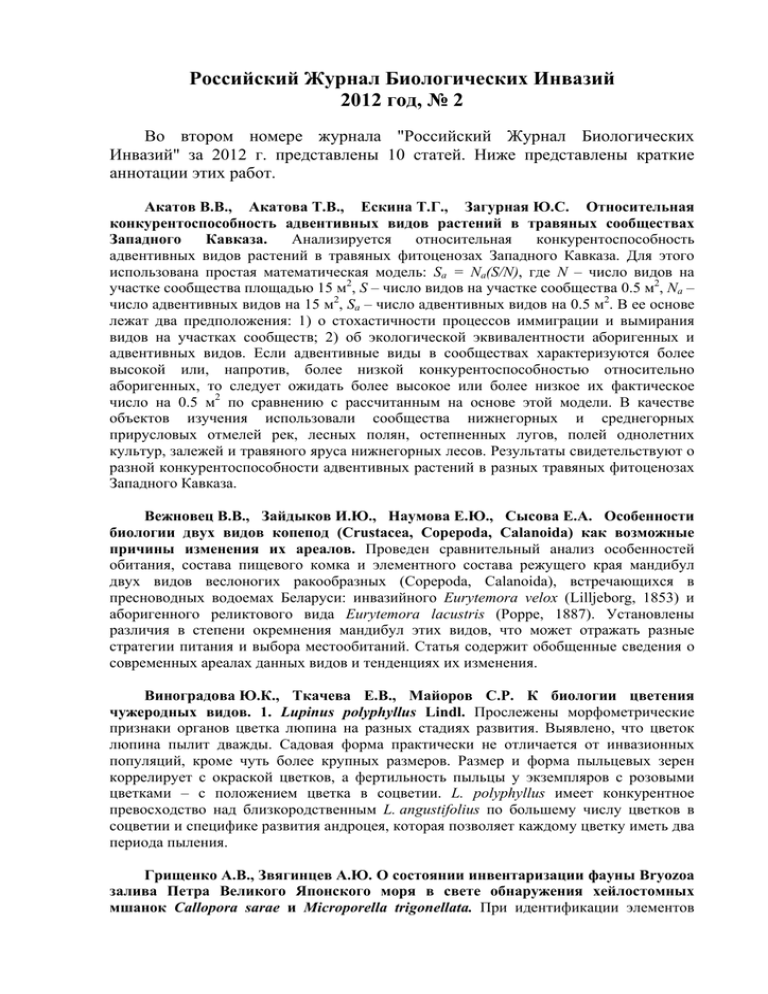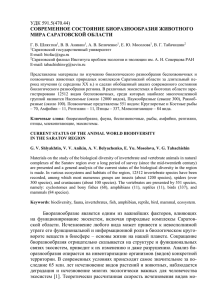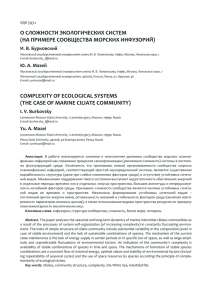Российский Журнал Биологических Инвазий 2012 год, № 2
advertisement

Российский Журнал Биологических Инвазий 2012 год, № 2 Во втором номере журнала "Российский Журнал Биологических Инвазий" за 2012 г. представлены 10 статей. Ниже представлены краткие аннотации этих работ. Акатов В.В., Акатова Т.В., Ескина Т.Г., Загурная Ю.С. Относительная конкурентоспособность адвентивных видов растений в травяных сообществах Западного Кавказа. Анализируется относительная конкурентоспособность адвентивных видов растений в травяных фитоценозах Западного Кавказа. Для этого использована простая математическая модель: Sa = Na(S/N), где N – число видов на участке сообщества площадью 15 м2, S – число видов на участке сообщества 0.5 м2, Na – число адвентивных видов на 15 м2, Sa – число адвентивных видов на 0.5 м2. В ее основе лежат два предположения: 1) о стохастичности процессов иммиграции и вымирания видов на участках сообществ; 2) об экологической эквивалентности аборигенных и адвентивных видов. Если адвентивные виды в сообществах характеризуются более высокой или, напротив, более низкой конкурентоспособностью относительно аборигенных, то следует ожидать более высокое или более низкое их фактическое число на 0.5 м2 по сравнению с рассчитанным на основе этой модели. В качестве объектов изучения использовали сообщества нижнегорных и среднегорных прирусловых отмелей рек, лесных полян, остепненных лугов, полей однолетних культур, залежей и травяного яруса нижнегорных лесов. Результаты свидетельствуют о разной конкурентоспособности адвентивных растений в разных травяных фитоценозах Западного Кавказа. Вежновец В.В., Зайдыков И.Ю., Наумова Е.Ю., Сысова Е.А. Особенности биологии двух видов копепод (Crustacea, Copepoda, Calanoida) как возможные причины изменения их ареалов. Проведен сравнительный анализ особенностей обитания, состава пищевого комка и элементного состава режущего края мандибул двух видов веслоногих ракообразных (Copepoda, Calanoida), встречающихся в пресноводных водоемах Беларуси: инвазийного Eurytemora velox (Lilljeborg, 1853) и аборигенного реликтового вида Eurytemora lacustris (Poppe, 1887). Установлены различия в степени окремнения мандибул этих видов, что может отражать разные стратегии питания и выбора местообитаний. Статья содержит обобщенные сведения о современных ареалах данных видов и тенденциях их изменения. Виноградова Ю.К., Ткачева Е.В., Майоров С.Р. К биологии цветения чужеродных видов. 1. Lupinus polyphyllus Lindl. Прослежены морфометрические признаки органов цветка люпина на разных стадиях развития. Выявлено, что цветок люпина пылит дважды. Садовая форма практически не отличается от инвазионных популяций, кроме чуть более крупных размеров. Размер и форма пыльцевых зерен коррелирует с окраской цветков, а фертильность пыльцы у экземпляров с розовыми цветками – с положением цветка в соцветии. L. polyphyllus имеет конкурентное превосходство над близкородственным L. angustifolius по большему числу цветков в соцветии и специфике развития андроцея, которая позволяет каждому цветку иметь два периода пыления. Грищенко А.В., Звягинцев А.Ю. О состоянии инвентаризации фауны Bryozoa залива Петра Великого Японского моря в свете обнаружения хейлостомных мшанок Callopora sarae и Microporella trigonellata. При идентификации элементов обрастания причальных сооружений в Амурском заливе (зал. Петра Великого Японского моря) обнаружено два вида мшанок, Callopora sarae Grischenko, Dick et Mawatari, 2007 и Microporella trigonellata Suwa et Mawatari, 1998, ранее не отмеченных в Японском море и дальневосточных морях России. Для того, чтобы выяснить, являются ли данные виды интродуцированными, либо они неверно определены в этом районе предыдущими исследователями, нами был проведен анализ степени инвентаризации фауны мшанок залива Петра Великого. Недостаточная изученность этой фауны позволяет предположить, что C. sarae и M. trigonellata являются аборигенными видами для этого района. Ескина Т.Г., Акатов В.В., Акатова Т.В. Состав и видовое богатство фитоценозов залежей с доминированием чужеродных видов (бассейн реки Белая, Западный Кавказ). В работе анализируется влияние чужеродных (адвентивных) доминантов (Erigeron annuus, Solidago canadensis, Ambrosia artemisiifolia, Asclepias syriaca и др.) на состав и видовое богатство фитоценозов залежей, расположенных в бассейне реки Белая на Западном Кавказе. Результаты показывают, что 1) адвентивные доминанты не оказывают существенного специфического влияния на состав залежных сообществ; 2) сообщества с более обильными адвентивными доминантами характеризуются более низким видовым богатством на участках площадью 0.5 м2 и 15 м2 в целом, меньшим числом аборигенных видов и большим числом адвентивных; 3) сообщества с более обильными адвентивными доминантами характеризуются более низкой средней встречаемостью на площадках 0.5 м2 как аборигенных, так и адвентивных видов растений. Однако связь между всеми этими характеристиками является слабой. Зверева Л.В., Звягинцев А.Ю., Ивин В.В. Микологическое исследование балластных вод и осадков коммерческих судов в порту Владивостока. В порту Владивостока впервые проведено микологическое исследование балластных вод и осадков коммерческих судов, курсирующих на Российско-Японской и РоссийскоКитайской линиях. В балластных водах и в осадках обнаружено 43 таксономические формы мицелиальных грибов из 11 родов анаморфных грибов и зигомицетов, среди которых доминируют виды из родов Aspergillus (14 таксономических форм) и Penicillium (9 таксономических форм). Обнаруженные в балластных водах мицелиальные грибы Aspergillus japonicus и Aspergillus sclerotiorum в морских местообитаниях (морская вода, донные осадки) в прибрежной зоне залива Петра Великого Японского моря не отмечены. Таксономический состав и экологобиологическая характеристика обнаруженных мицелиальных грибов в балластных водах и осадках свидетельствуют о значительном антропогенном загрязнении портовых экосистем Китая (Бохайский залив Желтого моря и река Янцзы) и определяют характер экологического риска при биоинвазии данных грибов в дальневосточные моря России. Курашов Е.А., Барбашова М.А., Барков Д.В., Русанов А.Г., Лаврова М.С. Инвазивные амфиподы как фактор трансформации экосистемы Ладожского озера. Оценена роль инвазивных амфипод (байкальский вид Gmelinoides fasciatus (Stebbing, 1899) и понто-каспийские Pontogammarus robustoides G.O. Sars, 1894 и Chelicorophium curvispinum (G.O. Sars, 1895)) в трансформации экосистемы Ладожского озера. Показано, что в настоящее время основную роль играет G. fasciatus. Вселение G. fasciatus в Ладожское озеро привело к увеличению продуктивности литоральных бентосных сообществ и более эффективной утилизации энергии, поступающей в литоральную зону. Подтверждена натурализация в озере P. robustoides и C. curvispinum. Зона их обитания может расшириться, а роль в литоральных местообитаниях возрасти. Оценка экологического состояния озера при помощи новых индексов концепции оценки рисков инвазий водных организмов показала высокую степень трансформации экосистемы Ладоги. Панасенко Н.Н., Ивенкова И.М., Елисеенко Е.П. Сообщества неофитов в Брянской области. На основе дедуктивного метода флористической классификации растительности установлено 5 дериватных сообществ, сформированных адвентивными видами: Solidago gigantea, Asclepias syriaca, Aster × salignus, Sorbaria sorbifolia, Spiraea alba. Приводится эколого-флористическая характеристика сообществ. Рудинская Л.В., Гусев А.А. Вселение североамериканского двустворчатого моллюска Rangia cuneata (G.B. Sowerby I, 1831) (Bivalvia: Mactridae) в Вислинский залив Балтийского моря. Североамериканский солоноватоводный двустворчатый моллюск Rangia cuneata (G.B. Sowerby I, 1831) впервые был зарегистрирован в Вислинском заливе Балтийского моря в сентябре 2010 г. Основываясь на особенностях его биологии, можно предположить, что вселение этого вида произошло как минимум на 2–3 года раньше, в 2007–2008 гг. В 2010–2011 гг. R. cuneata уже колонизировала и заселила достаточно обширную площадь залива. Максимальная численность ее популяций (до 4040 экз./м2) была отмечена в районах, прилегающих к Калининградскому морскому каналу. Наиболее вероятно проникновение R. cuneata в Вислинский залив связано с балластными водами судов, в том числе дноуглубительных, пришедших из районов, где этот моллюск уже натурализовался. В связи с угрозой новых серьезных трансформаций в экосистеме Вислинского залива вследствие натурализации R. cuneata рекомендуется усилить мониторинг донных экосистем залива. Kotenkova E.V., Maltzev A.N. The role of invasions in evolution of commensal taxa of Mus musculus sensu lato species group. One of most important evolutionary consequences of commensalisms and invasions in house mice is formation of hybrid zones of different kinds: a narrow 16-50 km wide zone of introgressive hybridization between M. musculus and M. domesticus in Central Europe, a well-studied "tension zone" of secondary contact; large complex hybrid zone in Trans-Caucasus – presumably hybrid events can occur here at different times and were "superposed" on gene pool of ancient autochtonous population; large zones of gene introgression in Asia between M. castaneus, M. domesticus and various subspecies of M. musculus; hybridization of different commensal taxa in large cities. Formation of these hybrid zones were consequence of invasions of commensal taxa of house mice and colonization of new territories by human agency. These zones are absolutely different in term of time and history of their formation and role of humans. It is possible to predict different ways of evolution in hybrid populations: (i) stabilization of hybrid genome, (ii) formation of premating reproductive isolation arise between parental taxa and hybrid population because of reinforcement and (iii) “dediffirentitiation” of closely related taxa. The analysis of different kinds of hybridization supports the hypothesis of “dediffirentitiation”. Russian Journal of Biological Invasions, 2012, issue 2 The second issue of the Russian Journal of Biological Invasions (2012) presents 10 articles. The brief summaries of these articles are presented below. Akatov V.V., Akatova T.V., Eskina T.G., Zagurnaja J.S. Relative competitive capacity of adventive plants in herbaceous phytocenosis of the Western Caucasus. Relative competitive capacity of adventive vascular plants in herbaceous phytocenosis of the Western Caucasus is analyzed. The simple mathematical model is used for this purpose: Sa = Na(S/N), where N is the number of species of vascular plants per site of 15 м2; S is the mean number of species of vascular plants per plot of 0.5 м2 within the sites; Na is the number of species of adventive plants per site of 15 м2; Sa is the mean number of adventive species per plot of 0.5 м2. This model is based on the assumptions that (a) all species constituting the species pool have the same capacity for dispersal and survival in colonized areas and (b) both immigration and extinction of the species are stochastic. If adventive species in community are characterized at average by higher or, on the contrary, by lower competitive capacity, in contrast to aboriginal species, so it should expect the higher or lower actual number of adventive species per plot of 0.5 м2 in contrast with accounted ones from the model. The objects of the study are open communities (groups) on shoals along low and mid mountain rivers; communities of mid mountain forest glades and low mountain steppificated meadows; communities of annual crop fields (wheat, corn, sunflower and soybean) and fallow lands; herb layer of low mountain forest communities. The results show different relative competitive capacity of adventive plants in different herbaceous communities of the Western Caucasus. Vezhnovets V.V., Zaidykov I.Yu., Naumova E.Yu., Sysova E.A. Biological peculiarities of two copepod species (Crustacea, Copepoda, Calanoida) as possible causes of changes of their ranges. A comparative analysis of the habitat characteristics, the gut content and the elemental composition of the cutting edge of the mandibles has been provided for two species of crustaceans (Copepoda, Calanoida), Eurytemora velox (Lilljeborg, 1853) and Eurytemora lacustris (Poppe, 1887). These representatives of the brackish and marine fauna inhabit the Belarusian freshwaters. The paper represents the generalized data on recent state and changes of species' ranges. The differences in the silicification of mandibles of species may reflect the different nutrition strategies and habitat selection. Vinogradova Yu.K., Тkaсheva E.V., Mayorov S.R. About flowering biology of alien species. 1. Lupinus polyphyllus Lindl. Morphological characters of floral element of Lupinus polyphyllus at different stages of development are retraced. It is revealed that a blossom dust is emited twice. The garden form practically doesn't differ from invasive populations, except, unless, hardly larger size. The size and the form of pollen grains correlate with the color of florets. The pollen fertility of pink florets is depended of its position in an inflorescence – the main or lateral parts. L. polyphyllus has the competitive superiority over closely related L. angustifolius in more number of florets in an inflorescence and specificity of androecium which allows each flower emits a blossom dust twice. Grisсhenko A.V., Zvyagintsev A.Yu. On the state of inventory of the bryozoan fauna of Peter the Great Gulf of the Sea of Japan in light of detection of the cheilostome bryozoans Callopora sarae and Microporella trigonellata. In a course of taxonomic study of the fouling community collected from the petrol wharf in Amurskiy Bay (Peter the Geat Gulf, the Sea of Japan) two cheilostome bryozoan species (Callopora sarae Grischenko, Dick et Mawatari, 2007, and Microporella trigonellata Suwa et Mawatari, 1998) were encountered. These species were never reported from either the Sea of Japan or the Far Eastern seas before. We analyzed the extent and reliability of the previous inventory of the bryozoan fauna in the Peter the Great Gulf to clarify the status of these species as introduced elements and to exclude the possibility of their incorrect determination. We demonstrate that the degree of inventory of the bryozoan fauna in the Peter the Great Gulf to date is insufficient to exclude the autochthonic distribution of C. sarae and M. trigonellata in this region, and thus is insufficient to unequivocally interpret their status. Eskina T.G., Akatov V.V., Akatova T.V. Composition and species richness of fallow plant communities with predominance of adventive species (the Belaya River basin, Western Caucasus). The influence of adventive dominants (Erigeron annuus, Solidago canadensis, Ambrosia artemisiifolia, Asclepias syriaca etc.) on composition and species richness of fallow plant communities (the Belaya River basin, the Western Caucasus) are analyzed. The results show that 1) adventive dominants influence poorly on composition of fallow communities; 2) communities with more abundant adventive dominants are characterized by the lower community species richness on the plots of 0.5 м2 and 16 м2 as a whole, and lesser number of native species and the higher number of adventive ones; 3) communities with the more abundant adventive dominants are characterized by the lower average frequency of native and adventive species on the plots of 0.5 м2. However, relations between all these characteristics are poor. Zvereva L.V., Zvyagintsev A.Yu., Ivin V.V. Mycological study of ballast waters and sediments of commercial ships in Vladivostok port. The mycological study of ballast waters and sediments of commercial ships, which ply in the Russian- Japanese and RussianChinese lines, is carried out in the port of Vladivostok for the first time. Fourty three taxa of mycelial fungi of 11 genus of anamorphic fungi and zygomycetes are discovered in the ballast waters and in the sediments, among which the species from the genera Aspergillus (14) and Penicillium (9) prevail. The mycelial fungi Aspergillus japonicus and A. sclerotiorum from the ballast waters were not encountered in the marine localities (sea water, benthic sedimentations) in the coastal areas of Peter the Great Bay (the Sea of Japan). The taxonomic composition of mycelial fungi and the ecological-biological characteristic of the discovered species in the ballast waters and the sediments testify to the significant anthropogenic impact on the coastal ecosystems in the region of the Bohai Bay of the Yellow Sea and Yangtze River. These data determine the nature of ecological risk with bioinvasions of fungi into the Far-Eastern seas of Russia. Kurashov E.A., Barbashova M.A., Barkov D.V., Rusanov A.G., Lavrova M.S. Invasive amphipods as a factor of Ladoga Lake ecosystem transformation. The role of invasive amphipods (Baikalian Gmelinoides fasciatus (Stebbing, 1899) and Ponto-Caspian Pontogammarus robustoides G.O. Sars, 1894 and Chelicorophium curvispinum (G.O. Sars, 1895)) in transformation of Lake Ladoga ecosystem is estimated. It is shown, that G. fasciatus plays the main role at the present time. Invasion of G. fasciatus into Lake Ladoga has led to an increase of productivity of littoral benthic communities and more effective utilization of the energy inflowing into the littoral zone. Naturalization of P. robustoides and C. curvispinum in the lake is confirmed. The zone of their dwelling can extend, and the role in the littoral habitats may increase. The analysis of an ecological state of lake with new indexes of the concept of assessing the risks of aquatic species invasions has shown a high degree of transformation of Lake Ladoga ecosystem. Panasenko N.N., Ivenkova I.M., Eliseenko E.P. Communities of neophytes in Bryansk Region. On the basis of the deductive approach 5 derivative communities formed by adventive species Solidago gigantea, Asclepias syriaca, Aster × salignus, Sorbaria sorbifolia, and Spiraea alba are established. The ecological and floristic characteristics of communities are given. Rudinskaya L.V., Gusev A.A. Invasion of the north american clam of Rangia cuneata (G.B. Sowerby I, 1831) (Bivalvia: Mactridae) in the Vistula Lagoon of the Baltic Sea. North American brackish water bivalve of Rangia cuneata (G.B. Sowerby I, 1831) was first recorded in the Vistula Lagoon of the Baltic Sea in September 2010. Based on the features of its biology, we can assume that the invasion in the Vistula Lagoon was at least 2-3 years earlier, in 2007-2008. In 2010-2011 R. cuneata colonized and occupied sufficiently large area of the lagoon. The maximum abundance (up to 4040 ind/m2) was observed in adjacent areas to the Kaliningrad sea channel. The most likely invasion way of R. cuneata in the Vistula Lagoon is connected with the ballast water of ships, including dredging ships, which came from areas where the clams are already naturalized. The naturalization of R. cuneata creates a threat of new serious transformations in the ecosystem of the Vistula Lagoon, which requires increased monitoring of its benthic ecosystems. Kotenkova E.V., Maltzev A.N. The role of invasions in evolution of commensal taxa of Mus musculus sensu lato species group. One of most important evolutionary consequences of commensalisms and invasions in house mice is formation of hybrid zones of different kinds: a narrow 16-50 km wide zone of introgressive hybridization between M. musculus and M. domesticus in Central Europe, a well-studied "tension zone" of secondary contact; large complex hybrid zone in Trans-Caucasus – presumably hybrid events can occur here at different times and were "superposed" on gene pool of ancient autochtonous population; large zones of gene introgression in Asia between M. castaneus, M. domesticus and various subspecies of M. musculus; hybridization of different commensal taxa in large cities. Formation of these hybrid zones were consequence of invasions of commensal taxa of house mice and colonization of new territories by human agency. These zones are absolutely different in term of time and history of their formation and role of humans. It is possible to predict different ways of evolution in hybrid populations: (i) stabilization of hybrid genome, (ii) formation of premating reproductive isolation arise between parental taxa and hybrid population because of reinforcement and (iii) “dediffirentitiation” of closely related taxa. The analysis of different kinds of hybridization supports the hypothesis of “dediffirentitiation”.

